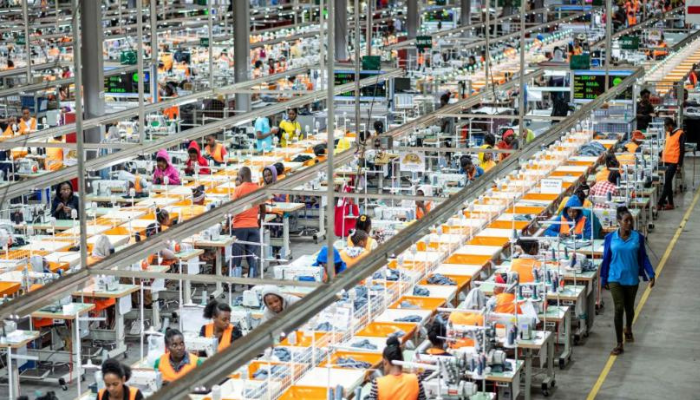Nigeria’s industrialization fails to gather steam after 65 years
After 65 years of independence, Nigeria’s over-dependence on imports has stalled its transformation from an agrarian economy to an industrial one.
After gaining independence in 1960, the Nigerian government implemented the Import Substitution Policy to curb import dependency, create jobs, and preserve foreign exchange, marking a strategic shift towards industrialisation.
This was seen as a diametrically superb policy that was targeted at transforming the country from an agrarian to an industrial economy.
However, the policy failed because early policy-makers believed that protectionism was a cure-all for the country’s fledgling economy.
Since then, past governments have adopted various policies aimed at reducing over-dependence on imports, creating a high number of local jobs and saving foreign exchange.
Read also: Nigeria among the top 5 African economies by GDP in Q3 2025
Some of the policies are the Nigerian Enterprises Promotion Decree, Structural Adjustment Policy, Small and Medium Industries Equity Investment Scheme, National Industrial Revolution Plan, National Automotive Policy and the Export Expansion Grant.
But lack of implementation and continuity in the policies has slowed the progress of the country’s industrial revolution.
According to the National Bureau of Statistics (NBS), growth in the manufacturing sector grew to 1.6 percent in the second quarter of 2025 from 1.28 percent in the same period in 2024.
Nnanyelugo Ike-Muonso, director-general of the Raw Materials, Research and Development Council (RMRDC), said that Nigeria must reduce its dependence on imported raw materials by at least 60 percent within the next five years if it is to become an industrial nation.
“Over 70 per cent of manufacturing inputs used in our economy are imported. These data points expose a structural weakness,” Ike-Muonso said in August at MAN’s equipment expo in Lagos.
“We export our raw materials in their crude form, import in refined quality, and surrender jobs and value offshore before we have even begun,” he said.
He argued that the country has the potential to industrialise rapidly, with over 120 commercially viable solid minerals, vast agricultural resources, and a large youthful population.
But Ike-Muonso reiterated that what is missing is “strategic coordination, bold implementation, and technology-backed commitment.”
While industrialisation has been a cornerstone of transformation in developed nations, Nigeria still lack the bustling facilities and vibrant industrial landscapes that characterise strong economies, despite its significant manufacturing capability and promising trajectories.
The availability of adequate infrastructure is also a major determinant of the success of every country’s industrial sector; however, Nigeria does not have adequate infrastructure to grow businesses, especially developed transport systems such as roads and railways connected to the nation’s seaports.
From Agbara industrial cluster in Ogun to Apapa in Lagos, roads are bad or inaccessible. Access roads to Apapa and Tin Can ports – Nigeria’s two main ports have continued to be nightmares for manufacturers and exporters.
Read also: Nigeria @ 65: From political freedom to creative economy
It is impossible to talk about infrastructure without discussing power. Energy is a key element of the production process. Nigeria’s inability to supply and distribute sufficient electricity has left businesses at the mercy of generators powered by diesel and petrol, whose prices have surged in recent months.
This raises the production costs for manufacturers significantly and forecloses their chances of competing with international peers.
According to the Manufacturers Association of Nigeria (MAN), manufacturers spend 40 percent of their total production cost on generating energy for their businesses.
Nigerian manufacturers suffered from a long-running shortage of foreign exchange and a sharp devaluation in 2024, which made doing business in the country complicated.
In 2024, the naira lost 40.9 percent of its value against the dollar in the official market despite notable growth in external reserves within the period, according to BusinessDay analysis.
The floating of the naira increased the official exchange rate from N463.38/$ on June 9 in 2023, to N1,500/$ as of October 3 in 2025.
The high cost of dollars and the implementation of a 7.5 percent value added tax on diesel imports have pushed its pump price to as high as N1,200 per litre.
The number of registered manufacturing firms with the MAN dropped from 4,850 in the early 1980s to 2,000 in 2010. From 2017-2024, more than 50 manufacturing companies have shut down.
Some of them are Surest Foam Limited, Mufex, Framan Industries, MZM Continental, Nipol Industries, Moak Industries, Stone Industries, Procter & Gamble, and GlaxoSmithKline, among others.
Regulation is a major issue hurting the sector. In Nigeria, Africa’s most populous country, agencies of the government work at cross-purposes.
For instance, the Standards Organisation of Nigeria (SON) does not accept tests done by the National Agency for Food and Drug Administration and Control (NAFDAC) and vice versa.
Read also: Nigeria at 65: From complaints to collective action
Worse still, their responsibilities overlap. Similarly, local or state governments do not accept agreements by the Federal Government, particularly when it has to do with money or taxes.
Nigeria is cash-strapped due to low oil prices and high debt servicing. This is hurting the country’s capacity to fund projects and critical sectors.
However, the pool of funds from the CBN and development finance institutions is stashed in banks, which are sometimes unwilling to lend to businesses due to what they call the ‘high-risk level’ of lending to businesses in Nigeria.
Consequently, several manufacturers have complained that they cannot access most funds advertised by the government.
While some manufacturers have accessed funding from the CBN, Bank of Industry and others, however, the funds are not easily accessible by all players.

